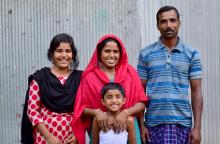
This course will introduce you to the main types and causes of malnutrition, provide a summary of some of the interventions used to prevent and manage malnutrition, and give an overview of how nutrition is measured and monitored. The course focuses mainly on the nutrition of women and children.
It is meant as a basic introduction to help you understand the problem of malnutrition, as well as common approaches for improving nutrition. Throughout this course, we will include links and references for more information. A glossary of key terms can be found in the menu to the right of the screen; glossary terms appear as underlined text within the course.
Objective
After completing this course, you should be able to—
- Identify the basic concepts of good nutrition for individuals and within populations.
- Identify the major nutritional deficiencies.
- Recognize nutrition in terms of a life cycle and the importance of the first 1,000 days.
- Identify the immediate and underlying causes of malnutrition.
- Recognize the rationale for a multi-sectoral approach to improving nutrition.
- Recognize evidence-based nutrition interventions.
Credits
This course was originally developed in 2016, and was updated and revised in 2018 and 2023 to reflect recent research and developments in global nutrition. The course authors wish to acknowledge the technical and programmatic contributions of Renata Seidel and the FANTA II project, who developed the original course on which this revised version was based.
We are grateful to Ian Gorecki and Alyssa Klein at SPRING for their support in the 2018 revision, and Akriti Singh, Alyssa Klein, Karin Christianson, and Courtney Meyer from USAID Advancing Nutrition for their support in the 2023 revision.
Time
- 3 hours
Published/Updated
- Thursday, February 29, 2024
Course Authors:
Gwyneth Cotes, SPRING
Altrena Mukuria, SPRING
Abigail Kaplan Ramage
Course Managers:
- Amy Lee, CCP
